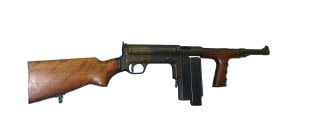At 1,000 Rounds Per Minute, the Nazis Were Right to Fear the M42 Machine Gun
The M42 was a fast firing gun, at nearly one thousand rounds per minute, and could operate in semi- and fully-automatic.
Here's What You Need to Remember: Thanks to small production numbers, the M42 is a relatively obscure weapon. The fact that it was never officially adopted by the United States as a standard-issue service weapon means it also didn’t help. But, the M42’s history as a resistance weapon actually makes it more interesting.
When the words “submachine gun” and World War II are said in the same sentence, a few venerable weapons probably come to mind. There is the German MP 40 submachine gun, which was a mass-production dream. Or the American Thompson submachine gun may come to mind. The Soviet Union’s iconic PPsH-41 is another contender for the most well-known Second World War design. A few others are somewhat lesser-known.
Some, like the homemade Błyskawica—Polish for lightning—manufactured by the Polish Resistance, is relatively obscure. As is this particular weapon, the M42, which was intended to supplant the Thompson. Although it didn't succeed, it was a great little gun.
Pricey
Just about the only downside to the venerable Thompson submachine gun was its price point. At more than $200, the Thompson was really expensive. Put into today’s dollars, it would have cost more than $3,000! The company that designed the M42 tried to remedy that with a cheaper alternative.
Like the Thompson, the M42 was also initially chambered in the powerful .45 ACP pistol cartridge, though actual production models opted for the smaller 9 millimeter round. The choice of the 9 millimeter round was a strategic one — the M42 was mostly used behind Axis lines in Europe, where the ubiquitous 9 millimeter round could be found virtually anywhere, whereas the American .45 ACP would be difficult to scrounge and next to impossible to manufacture.
The M42 was a fast firing gun, at nearly one thousand rounds per minute, and could operate in semi- and fully-automatic. The standard magazine has a paltry twenty-round capacity, which was quickly emptied. In order to remedy this, the manufacturer designed and built a standard-issue jungle-style clip in which two standard magazines were welded together back to back for faster reloading. Though this made reloading somewhat quicker, it also exposed the bottom clip to dust and dirt, potentially jamming the weapon if not kept spotlessly clean.
Office of Strategic Services
While the United States never officially adopted the M42, it was used by the OSS, or Office of Strategic Services, the precursor to the Central Intelligence Agency. The OSS used the M42 to arm their own, as well as Nazi resistance groups and partisans far and wide.
The M42 was dropped via air to a number of partisan groups in Europe. Greek partisans, Norwegians, the Free French, Belgium, Holland—you name it, wherever there were partisans or resistance fighters, they were supplied.
Postscript
Thanks to small production numbers, the M42 is a relatively obscure weapon. The fact that it was never officially adopted by the United States as a standard-issue service weapon means it also didn’t help. But, the M42’s history as a resistance weapon actually makes it more interesting.
Caleb Larson is a defense writer with the National Interest. He holds a Master of Public Policy and covers U.S. and Russian security, European defense issues, and German politics and culture. This article is being republished due to reader interest.
Image: Wikimedia Commons.

